What is a Dampp-Chaser Piano Life Saver System?
Pianos are creatures of humidity: Small changes in relative humidity can dramatically alter both the tuning and the lifespan of the instrument. Many customers struggle to keep the space around their piano at the recommended 42-45% humidity.
To solve this problem, the Dampp-Chaser Piano Life Saver System is a humidity control system installed either inside, underneath, or behind your instrument that regulates the humidity year-round. It controls the humidity of the air closest to your piano’s critical components, such as the soundboard. Particularly for my customers here in Maine, that’s much easier than trying to control a whole room (or worse, an entire church sanctuary).
The system operates using a small, evaporative humidifier, heater elements, and a sensor. Installations vary considerably between instruments, so these are typically sold and installed by piano technicians.
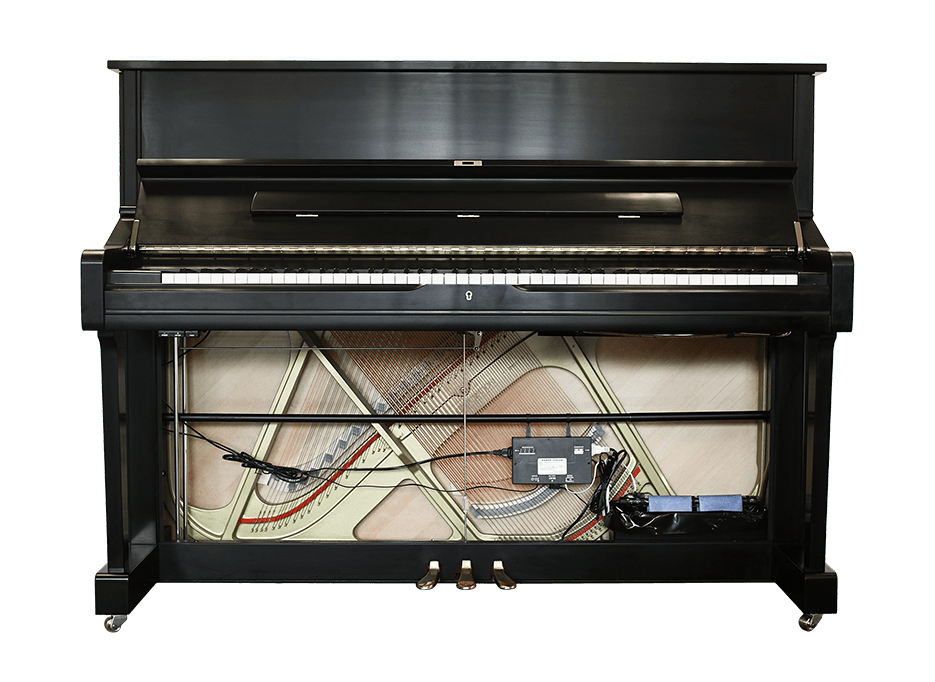
Do Dampp-Chaser Systems help with tuning stability?
Yes, Dampp-Chaser Piano Life Saver Systems do help your piano hold a tune for longer. I always recommend maintaining stable humidity in the room the piano resides in if possible. Although this is the best possible solution for the piano, it can be quite challenging. The Piano Life Saver System solves this problem by protecting only the space inside or underneath the piano.
If controlling the humidity in the room isn’t practical or possible, then consider purchasing a Dampp-Chaser Piano Life Saver System. These systems can protect the most vulnerable parts of your piano and assist with tuning stability, even in unstable and extreme environments.
But I didn’t just take their word for it! I’ve installed remote humidity sensors in several pianos. My finding is that Dampp-Chasers do, in fact, keep the humidity inside pianos noticeably more stable. They’re particularly effective at keeping summer humidity under control, and are capable of bracing pianos against even the high humidity of a coastal Maine summer. The graph below depicts the performance of the system in a Vose & Sons baby grand piano located in a church:
The above piano has far more tuning stability than it did before, and the Dampp-Chaser will also protect against mold and corrosion. The piano in the above graph does have an undercover installed, and I nearly always recommend including these on grand installations.
This chart shows typical wintertime performance. The green line indicates outdoor humidity (not included in the first chart). As you can see, outdoor humidity varies tremendously during the Maine winter. The humidity routinely reaches nearly 100%! The air, once heated, dries out considerably, and you can see this relationship represented by the blue line. Finally, the red line represents the humidity as measured at the piano itself, and you can see the Dampp-Chaser effectively smooths out the variation.
Do I actually need a Dampp-Chaser?
Dampp-Chaser Piano Life Saver systems do an excellent job protecting your piano, but is it actually necessary? Can you do just as well without it? Well, yes, you can! However, expect to do a bit more work.
Pianos are creatures of humidity. Humidity is not the same thing as temperature. Customers frequently remark that the “temperature in their house is very stable” when I comment on unstable humidity. That means very little with respect to humidity, and in fact, stable temperature might be part of the problem!
The first step in figuring out how your house compares is to invest in a good-quality hygrometer. Customers often show me $5 hardware store hygrometers, and tell me it hardly ever changes! Well, that’s because it wouldn’t change its reading if you dunked it underwater: It’s a useless hygrometer. Your measurements are only as accurate as your measurement tool, and even a $30 unit such as the Oasis OH-2 will do a much better job than your average box store special.
The goal is to keep the humidity in the room at about 42-45%. To do this, you’ll need to humidify in the winter, and dehumidify in the summer. You can see my recommended list of humidifiers here. How much of each you’ll have to do depends heavily on your house and the local climate.
Here in Maine, it’s nearly impossible to manage the humidity in most homes, and I find that I almost always recommend the Dampp-Chaser. However, in your home and situation, you may be able to get along very nicely without it.
How much do Dampp-Chaser systems cost?
I now have a full article where I explain how much you can expect to pay for one of these systems. Many factors go into the price, including whether your piano is a grand or upright, whether it contains a player system, the environment your piano is kept in, and more.
Do Dampp-Chaser Systems protect my piano from Extreme Humidity?
Yes, the Dampp-Chaser protects several of the main structural components of your piano from the harshest extremes. During the winter months, in some evenings the relative humidity indoors can be as low as 10%. (I’ve measured as low as 5% in some customer’s houses.) This is close to the humidity the piano might experience in Death Valley during the summer. Conversely, Maine summers can see relative humidity clearing 80%. Both of these extremes can be absolutely devastating for soundboards, bridges, and other finely constructed wooden components and glue joints.
The dehumidifier also does a superb job keeping out condensation and mold. You can also install a dehumidifier only system (about a third the cost of the full system) in pianos susceptible to mold. Please see my Cleaning FAQ for more on mold.
However, it’s important to mention that the Dampp-Chaser system does NOT protect the pinblock. The Dampp-Chaser offers significant protection. However, you should always control the humidity of the room whenever possible.
Does the piano have to be tuned after the Dampp-Chaser is installed?
The piano will settle after the Dampp-Chaser is installed, and the tuning will change. The usual recommendation is to wait at least two weeks for the piano to settle before tuning it.
Can a Dampp-Chaser be installed at the same time as a tuning?
No, you should not install a Dampp-Chaser and tune the piano the same day. After the Dampp-Chaser is installed, the piano will settle, and the tuning will change.
A Dampp-Chaser installation is, in many ways, equivalent to a piano move. If you tune the piano at the same appointment, the piano is very likely to go out of tune within the week.
You should view suspiciously any technician that advises installing a Dampp-Chaser and tuning on the same day!
Do I need to do anything once it’s installed?
Your only obligation is filling the humidifier with distilled water when it requires it. There’s a light installed on the piano that will flash when the system needs to be filled, and it comes with a special fill bucket.
The humidifier will require a new set of humidifier pads every six months. I provide these for free at regular tuneups. The pads are the only component which must be frequently replaced.
As a rule, your technician does this work. However, you can purchase these pads on their own, or you can purchase them in a set which includes a new liner and a new clean sleeve, which is a plastic protector that slips over the humidifier. Finally, they sell everything you need in one kit, which includes the liner, clean sleeve, pads, and pad treatment.
Do they wear out?
The Dampp-Chaser system has no moving parts, so they typically last for decades. However, the lifespan of your system can vary considerably based on usage and maintenance.
If you want your system to last a long time with minimal maintenance, you must use only distilled water when filling your system. Household water contains minerals, and those minerals can accumulate on the humidifier. Over time, corrosion will develop, prematurely aging the system. You should also use one capful of pad treatment each time you fill the humidifier. This prevents bacteria from growing.
Tuning stability still isn’t great. What else can I do?
Reposition the Piano
It may be that the piano is simply in such a hopelessly volatile environment that it can’t hold a tune, even with a Dampp-Chaser. The most common reasons for this follow:
The piano is positioned such that it receives direct, hot sunlight directly on its soundboard for portions of the day. This is particularly true of uprights in front of windows.
The piano is positioned within five feet of a heat or humidity source. All heat sources are problematic, but baseboard heaters behind upright pianos are some of the worst offenders. Radiant floor heat can also be very problematic. Humidifiers can be placed too close to the piano: Keep those five feet away as well.
The piano is located in a room that swings wildly in temperature and humidity, such as a living room heated only by a wood stove. If you have a grand in such an environment, a Dampp-Chaser undercover is mandatory.
The piano is exposed to considerable airflow, such as being located near a door or forced air vent. The Dampp-Chaser will require an undercover in this environment as well.
Add an Undercover
This applies only to grand piano systems.
While the Dampp-Chaser system is correctly controlling humidity around the sensitive area beneath the soundboard, some of its effectiveness is lost when the humidity control escapes into the broader environment. This is particularly true of large, drafty, and open spaces. By adding the undercover to your existing Dampp-Chaser setup, you seal in the microclimate directly beneath the soundboard. The undercover effectively locks in the desired humidity levels, ensuring that the critical area remains protected from external fluctuations.
This additional barrier can significantly enhance the overall performance of the humidity control system, providing a more stable environment for your piano and ultimately reducing tuning drift.
It Might be the Piano
The reality is that, despite your best efforts, some pianos don’t hold a tune. I’ve tuned some low quality baby grand pianos, and some low quality spinets, which shift nearly a half-step between tunings, even with Dampp-Chaser systems installed. This is rare — the environment is usually at fault — but it does happen.
Why do Dampp-Chaser system installation quotes vary so much?
I now have a full article on Dampp-Chaser pricing, due to popular demand. But in short, the Dampp-Chaser is a retail product, sold through technicians. The technician acts as both the installer and the retailer. Aside from the initial price of the product and any delivery fees, the technician will add a retail markup and then add their installation fee, which might be flat rate or hourly.
Different technicians handle this pricing structure very differently, and you’ll see Dampp-Chaser quotes ranging widely. Additionally, different technicians may include different parts of components in their base setup, such as undercovers or higher wattage systems. The most important detail is that your installer understands the system conceptually, and has experience adapting it to many pianos effectively. Every Dampp-Chaser installation is a bit unique—some very—and your installer needs to be up to the task.
Do I actually have to use Pad Treatment and Distilled Water?
I’ve cleaned out some horrific humidifier buckets throughout my career. Pad treatment prevents bacteria and mold from growing inside the humidifier. Use the recommended dosage of pad treatment—that’s one capful. I’ve had customers try to “pinch pennies” by using half the recommended amount, and yes, I’ve seen mold grow in the humidifier as a consequence. It won’t spread to the piano, as the dehumidifier protects the cabinet. However, it will create an awfully gross situation inside the humidifier, and you’ll need replacement hardware much sooner.
Remember that anything you put into the humidifier, stays in the humidifier. If your water has sediment in it, the sediment has nowhere to go. Dampp-Chaser recommends distilled water. I’ve seen customers use highly filtered water without any negative consequences, but I’ve also seen them use well water and grow massive deposits of iron, calcium, and salt on their humidifiers! These cause corrosion, and are messy. Use distilled water.
Pad treatment is available from Dampp-Chaser directly on Amazon. You can also buy it in pairs for a considerable discount. That said, a 16 oz bottle will last most people a year or more. If you have a piano technician, make sure to ask if they carry it, and always check with your local piano store.
But is Distilled Water really necessary? How bad can tap water be?
If you’ve been using tap water to fill your Dampp-Chaser, you’ll likely find some sediment on the humidifier pads. Because the humidifier works by evaporating the water, the sediment will accumulate on top of the humidifier element.
If your home draws from a well, the sediment can be particularly dramatic. Depending on your water supply, you might get differently sized or colored deposits—but you really don’t want any!
Over time, water drawn from a hard-water well evaporates inside the humidifier, leaving a chalky residue that first dusts the surface of the wick and heater bar, then fuses into a white crust or pastel green crystals.
These minerals can be very corrosive, damaging Dampp-Chaser components and brackets. Mineral layers block the wicking action, so the pads—now discolored—can’t lift water efficiently. The drier the pads get, the more the humidifier runs, which accelerates the rate of mineral accumulation. Your humidifier becomes less efficient, and eventually doesn’t work at all.
If you have sediment accumulation, replace the pads immediately. Thoroughly remove and clean the rest of the humidifier bucket.
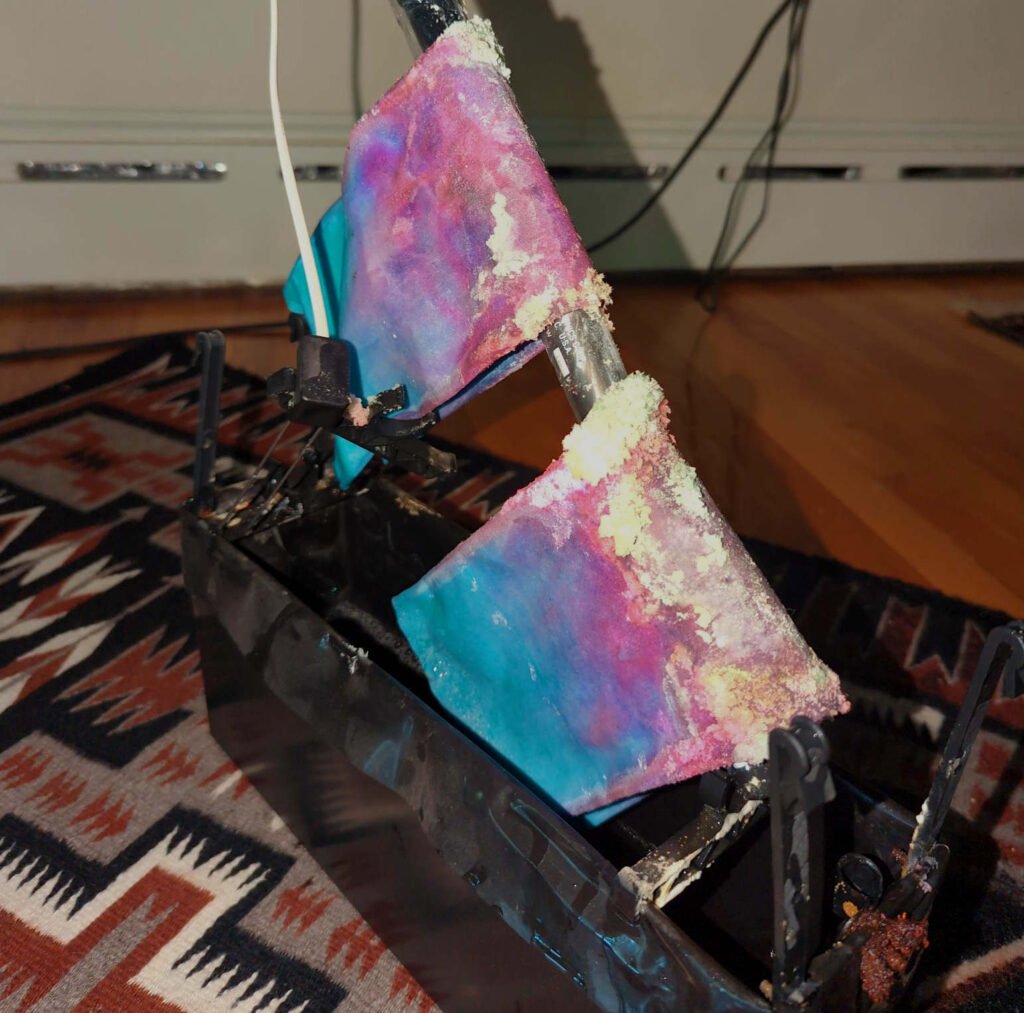
So when should I replace the Dampp-Chaser pads?
You should replace the Dampp-Chaser pads every six months. You can do this at the same time as your piano tuning, and your technician should do this work for you.
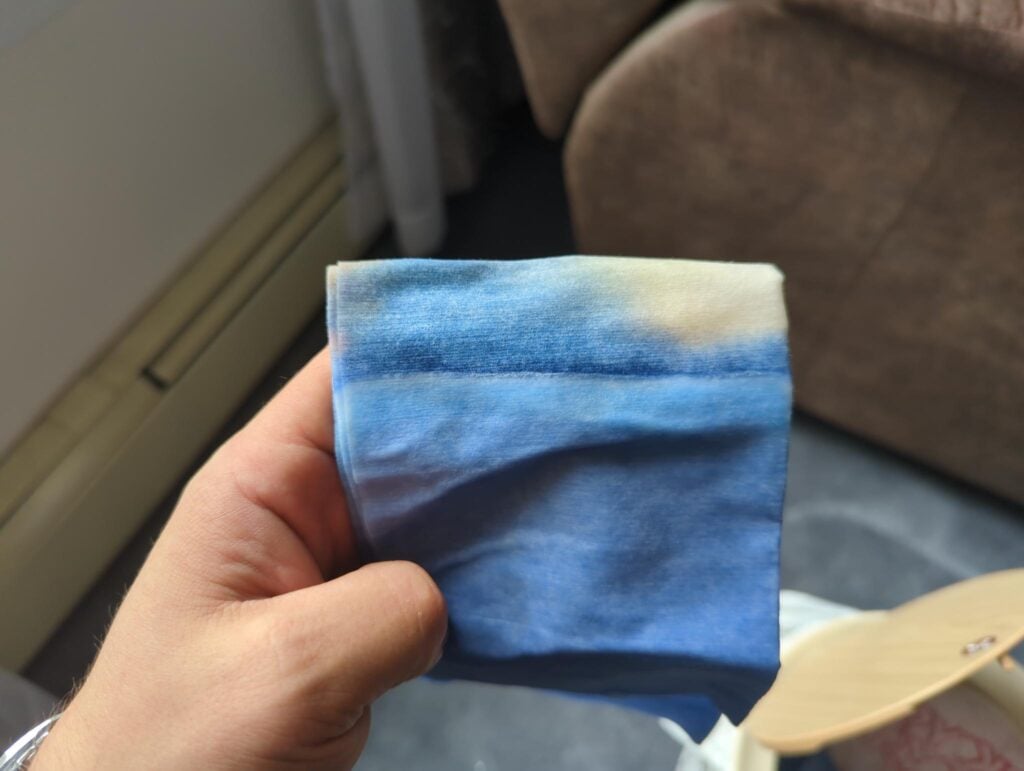
My Dampp-Chaser Won’t Turn On!
There are a couple of very common reasons for this. The most common is that the Dampp-Chaser is plugged into a switch-controlled outlet. Make sure this isn’t the case! This is such a universal source of consternation it was immortalized in The National Lampoon’s Christmas Vacation.
The other common reason is that the fuse has blown in the plug. The original Dampp-Chaser fuse is a 5 amp, 125-volt glass, 5 mm x 20 mm fast-acting fuse. Replace it with an exact equivalent. If one isn’t available, or if the plug is destroyed, either replace the humidistat by a piano technician, or have the plug replaced by a competent electrician.
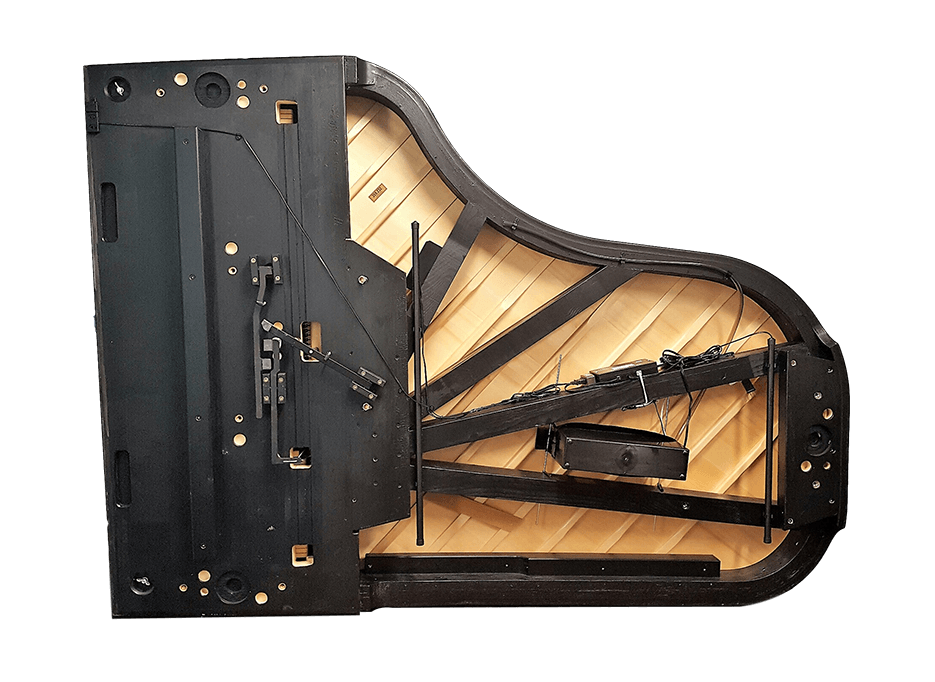
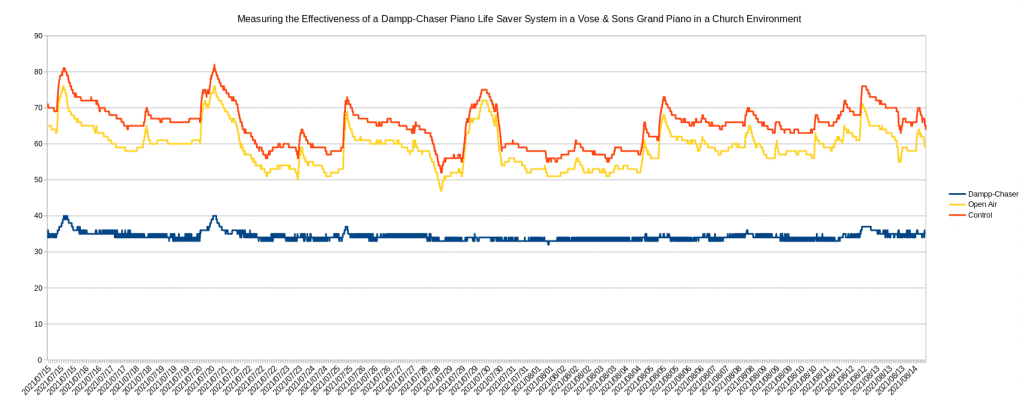
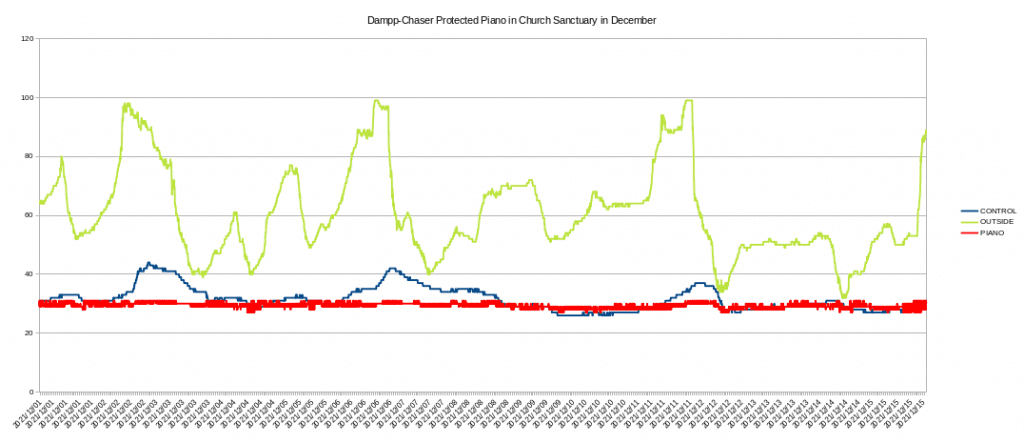
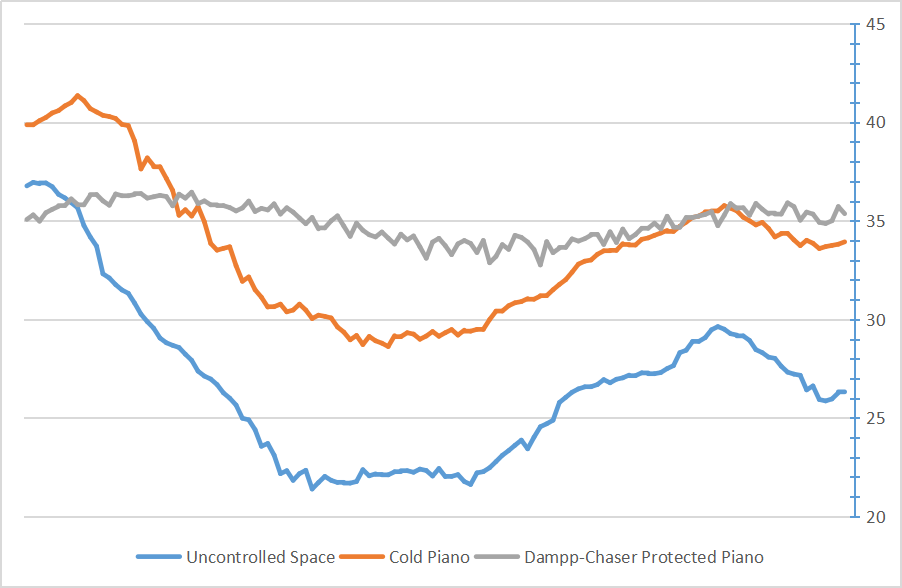
Dampp Chaser suddenly always green, never yellow, even when dry. What could cause this?!
Hello Irene,
The green light should always be on — it indicates the Dampp-Chaser is receiving power. However, the yellow light should flash any time the water level is low. Here are three components that might have failed.
The water sensor
You can test this by unplugging the water sensor from the humidistat. The humidistat is the rectangular black control box, and in newer designs the water sensor plugs into it with what looks like a little phone plug. If the yellow light starts blinking when you unplug it, and when the sensor is removed from water, then the sensor itself has failed. Check to make sure it isn’t bent or damaged, and that its two prongs aren’t touching anything, but if there’s nothing obviously wrong, you’ll have to order a new one.
(Note that in older systems, it does not unplug, and you’ll find it directly wired to the humidistat. In this case, you’ll have to replace much of the system, including the humidistat and water level sensor.)
The lights
The lights are a bit fragile. I’ve run into damaged lights multiple times. The easiest way to test for this is to replace them. If a tech comes to inspect it, they should be carrying a set of new lights to try.
The humidistat
If unplugging the water sensor does not cause the lights to blink, even with a known good set of lights, the humidistat needs to be replaced. This is the most expensive component to replace, so we always hope for a light or sensor problem, but these can fail.
If the system is less than five years old, it should be covered under warranty. If it’s older than that, you’ll need to order new parts from a technician (whether me or the person inspecting it).
The low water sensor on my system is broken (wire where is connects to the humidistat. Can I order a new one?
Hello Dave. I’d be happy to help! You can reply to me privately at[email protected]. Please photograph the connection—in some earlier systems, you’ll have to replace the entire humidistat. In the more recent ones, you can just replace the sensor itself, which will connect with a little plug.